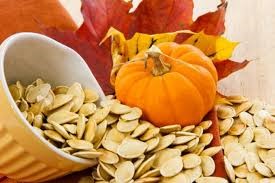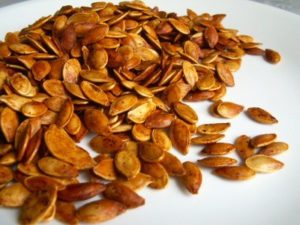The Most Sincere Pumpkin Patch…
Well, it is that time of year again…when the strong breezes are blowing down the kaleidoscope-color of leaves to blanket the ground. Many of those leaves will settle gently down in the pumpkin patches that are now more visible. For fans of the comic Charlie Brown, the time of the “Great Pumpkin” rising to visit the “most sincere pumpkin patch” is just around the corner.
A pumpkin is a cultivar of a squash plant, most commonly of Cucurbita pepo, that is round, with smooth, slightly ribbed skin, and deep yellow to orange coloration. The thick shell contains the seeds and pulp. Specific cultivars of winter squash derived from other species are also sometimes called “pumpkin.” In New Zealand and Australian English, the term pumpkin generally refers to the broader category called winter squash elsewhere. (reference: Wikipedia)
Pumpkin seeds, also known as pepitas, are edible and nutrient-rich. They are flat, asymmetrically oval, light green in color and usually covered by a white husk, although some pumpkin varieties produce seeds without them. Pumpkin seeds can be found hulled or semi-hulled at most grocery stores. Per ounce serving, pumpkin seeds are a good source of protein and contain the essential minerals magnesium, copper and zinc.
The World Health Organization recommends consuming pumpkin seeds as one of the best ways of obtaining the nutrient zinc. Additionally, they recommend that consumers consider purchasing them in unshelled form in order to maximize the amount of zinc. Although recent studies have shown there to be little zinc in the shell itself (the shell is also called the seed coat or husk), there is a very thin layer directly beneath the shell called the endosperm envelope, and it is often pressed up very tightly against the shell. Zinc is especially concentrated in this endosperm envelope.  Because it can be tricky to separate the endosperm envelope from the shell, eating the entire pumpkin seed—shell and all—will ensure that all of the zinc-containing portions of the seed will be consumed. Whole roasted, unshelled pumpkin seeds contain about 10 milligrams of zinc per 3.5 ounces, while shelled roasted pumpkin seeds contain about 7-8 milligrams. Even though the difference is not huge, and the seed kernels remain a good source of zinc, you’ll be able to increase your zinc intake if you consume the unshelled version. (reference: The World’s Healthiest Foods)
Because it can be tricky to separate the endosperm envelope from the shell, eating the entire pumpkin seed—shell and all—will ensure that all of the zinc-containing portions of the seed will be consumed. Whole roasted, unshelled pumpkin seeds contain about 10 milligrams of zinc per 3.5 ounces, while shelled roasted pumpkin seeds contain about 7-8 milligrams. Even though the difference is not huge, and the seed kernels remain a good source of zinc, you’ll be able to increase your zinc intake if you consume the unshelled version. (reference: The World’s Healthiest Foods)
Pumpkin seed oil is pressed from roasted pumpkin seeds, is thick, and appears red or green in color depending on the oil layer thickness. When used for cooking or as a salad dressing, pumpkin seed oil is generally mixed with other oils because of its robust flavor. Used in cooking in central and eastern Europe, it is considered a delicacy in traditional local cuisines such as for pumpkin soup, potato salad or even vanilla ice cream. Pumpkin seed oil contains essential fatty acids, such as oleic acid and alpha-linolenic acid, which in studies have been found to be beneficial in reducing risk of heart disease.
Other uses and benefits:
Pumpkins have been used as folk medicine by Native Americans to treat intestinal worms and urinary ailments, and this Native American remedy was adopted by American doctors in the early nineteenth century as an anthelmintic for the expulsion of worms. In Germany and southeastern Europe, seeds of C. pepo were also used as folk remedies to treat irritable bladder and benign prostatic hyperplasia. In China, C. moschata seeds were also used in traditional Chinese medicine for the treatment of the parasitic disease schistosomiasis and for the expulsion of tape worms. Chinese studies have found that a combination of pumpkin seed and areca nut extracts was effective in the expulsion of Taenia spp. tapeworms in over 89% of cases.
Also, canned pumpkin is often recommended by veterinarians as a dietary supplement for dogs and cats that are experiencing certain digestive ailments such as constipation, diarrhea, or hairballs. The high fiber content helps to aid proper digestion. Raw pumpkin can be fed to poultry, as a supplement to regular feed, during the winter to help maintain egg production, which usually drops off during the cold months. (reference: Wikipedia)
MoreFit employees have a wealth of knowledge on nutrition and are available to provide guidance on how to maintain healthy eating habits during the coming cold months. Feel free to ask us anytime how we can assist you with improving your fitness levels with nutrition as well as group and individual training!
Billi-Jean
Morefit PT
How to roast pumpkin seeds (options from Food Network)
Preheat oven to 300 degrees F.
Using a spoon, scrape the pulp and seeds out of the pumpkin into a bowl.
Separate the seeds from the stringy pulp, rinse them in a colander under cold water, then shake dry. Do not blot with paper towels because the seeds will stick.
Spread the seeds in a single layer on an oiled baking sheets and roast for 30 minutes to dry them.
Flavoring options:
Add whichever spice preference by tossing the seeds with olive oil and choice of spices, then return to the oven and bake until crisp and golden, about 20 more minutes.
Sweet: Toss with cinnamon and sugar.
Indian: Toss with garam masala and salt; mix with currants after roasting.
Spanish: Toss with smoked paprika and salt; mix with slivered almonds after roasting.
Italian: Toss with grated parmesan, salt, and dried oregano.
Barbecue: Toss with brown sugar, salt, chipotle chile powder, and ground cumin.

